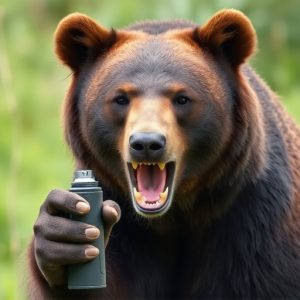Bear Repellent Spray: Essential for Hiking Safety and Environmental Considerations
Understanding bear behavior and the science behind bear spray is vital for hikers in regions with be…….
Understanding bear behavior and the science behind bear spray is vital for hikers in regions with bear populations, especially grizzlies known for their powerful sense of smell. Bear repellent spray acts as a crucial non-lethal tool, effective for deterring bears from minutes to hours, depending on quality and application techniques. Proper usage prevents spray soil contamination, ensuring optimal performance and minimizing environmental impact. Choosing sprays with higher capsaicin concentrations and proper disposal methods is essential. Effective application involves spraying continuously for 3-4 seconds at 20-25 feet, reapplying after sweating or rain in high bear activity areas to maintain protection without excessive use.
“As adventurers venture into bear country, understanding the importance of bear repellent spray is a vital step for ensuring safety. This comprehensive guide explores why carrying bear spray is no longer a choice but an essential hiking necessity. From deciphering bear behavior to demystifying the science behind its effectiveness, we delve into the key factors for choosing and applying bear spray correctly. Additionally, we discuss potential environmental impacts, including bear spray soil contamination and its duration of efficacy, providing hikers with a well-rounded approach to wildlife interactions.”
- Understanding Bear Behavior: Why Repellent Spray is Crucial
- The Science Behind Bear Spray: How It Works and Its Effectiveness
- Choosing the Right Bear Spray: Factors to Consider for Optimal Protection
- Application Techniques: Maximizing the Durability of Your Repellent
- Environmental Impact: Bear Spray Soil Contamination and Duration of Efficacy
Understanding Bear Behavior: Why Repellent Spray is Crucial
Understanding bear behavior is essential for any hiker or outdoors enthusiast, especially in regions where bears are prevalent. Bears, particularly grizzly bears, have a powerful sense of smell and can detect food from miles away. They primarily feed on plants, berries, and insects, but they also hunt large prey and scavenge carcasses. When humans encroach on their territory, bears may become defensive, especially if they feel threatened or if their cubs are nearby.
Bear repellent spray is a crucial tool for hikers as it provides an effective means of deterring bears without causing harm. This non-lethal spray creates an unpleasant odor that can repel bears for a duration ranging from several minutes to up to several hours, depending on the quality and ingredients. It’s important to note that proper usage and application techniques are key to ensuring its effectiveness, especially since bear spray soil contamination can reduce its performance. Using it responsibly and staying within recommended distances can help hikers minimize their impact on wildlife while enjoying the great outdoors safely.
The Science Behind Bear Spray: How It Works and Its Effectiveness
The Science Behind Bear Spray: How It Works and Its Effectiveness
Bear spray, also known as bear repellent, is a powerful tool for hikers and outdoors enthusiasts navigating areas with bear populations. Its effectiveness stems from a combination of ingredients that create an unpleasant sensory experience for bears. When sprayed, the active ingredients—typically capsaicin, a derivative of chili peppers, and other irritants—irrite the bear’s eyes, nose, and respiratory system. This causes the bear to recoil and retreat, providing hikers with precious time to escape or secure their bearings.
The spray’s durability is another critical factor. Bear spray is designed to remain effective for an extended duration, even under varying weather conditions, including rain. However, proper application techniques are crucial for optimal performance. Users should aim for the bear’s face and eyes, ensuring minimal soil contamination that could reduce its potency. Understanding these scientific principles and correct usage practices maximises the safety of individuals hiking in bear country.
Choosing the Right Bear Spray: Factors to Consider for Optimal Protection
When selecting bear spray, understanding its components and performance characteristics is key. First, consider the active ingredients; capsaicin, a common ingredient known for its effectiveness in pepper sprays, can be powerful but may not provide adequate protection against larger bears. Active ingredients like cayenne pepper or capsaecin in higher concentrations are recommended.
Additionally, bear spray’s effectiveness depends on proper usage and timing. Factors like spray range and duration of protection matter; ensure the spray has a sufficient reach to keep bears at bay and check the manufacturer’s instructions for recommended usage distances. Remember that no bear spray is 100% effective, but it can significantly reduce the risk of attacks, especially when combined with other precautions like making noise while hiking in bear country. Bear spray soil contamination is also a concern; choose sprays designed to minimize environmental impact and ensure responsible disposal methods to protect wildlife habitats.
Application Techniques: Maximizing the Durability of Your Repellent
When applying bear repellent spray, proper technique is key to maximizing its durability and effectiveness. One common mistake hikers make is not spraying enough. A good rule of thumb is to spray in a continuous stream for about 3-4 seconds at a range of 20-25 feet. This ensures an even coating on your body and clothing, creating a protective barrier against bears.
Additionally, pay attention to high-risk areas like your legs, face, and hands, which are more likely to come into direct contact with a bear. Remember, the spray forms a layer that can last up to several hours, but it’s crucial not to rely solely on this protection. Keep noise levels down, make yourself visible, and travel in groups to minimize potential bear encounters. Regularly reapply the spray after activities like sweating or rain to maintain its integrity, especially when navigating challenging terrain or areas with high bear activity, ensuring you’re protected against any chance of soil contamination from bear droppings or urine.
Environmental Impact: Bear Spray Soil Contamination and Duration of Efficacy
Bear spray, while effective at deterring bears during hikes, raises environmental concerns regarding soil contamination. When used improperly or in large quantities, the chemicals within bear spray can seep into the soil and potentially harm plant life and other wildlife. This is particularly problematic in sensitive ecosystems where bears are already protected.
The duration of efficacy for bear spray varies based on factors like weather conditions and the specific product. However, it’s crucial to remember that even if a single application deters a bear, repeated or excessive use can contribute to soil contamination. Proper usage, including aiming correctly and not overspraying, is essential to minimize environmental impact while maximizing the spray’s effectiveness during hikes.
In conclusion, bear repellent spray is an indispensable tool for hikers navigating regions with bear populations. Understanding bear behavior, the science behind its effectiveness, and proper application techniques ensure optimal protection against these powerful animals. While considerations regarding soil contamination and duration of efficacy are important, responsible use and awareness can minimize environmental impact, making bear spray a vital tool for outdoor enthusiasts to enjoy their adventures safely.


